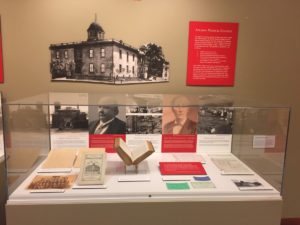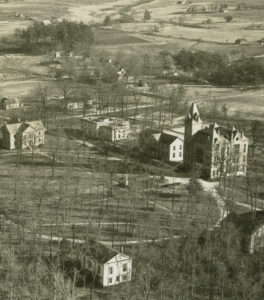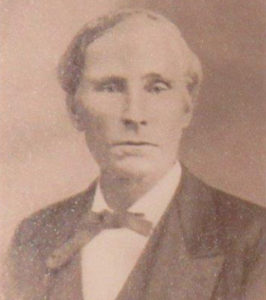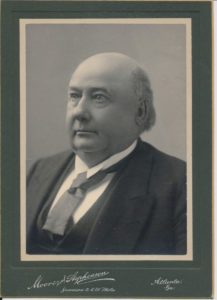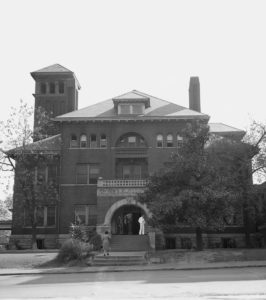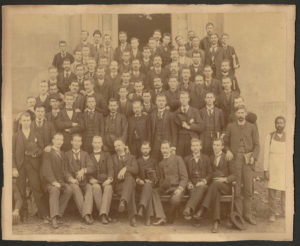Hello and welcome to a Virtual Walkthrough of the physical exhibit “History of Teaching Medicine at Emory University” located at the Woodruff Health Sciences Center Library. Due to Covid-19 we’re doing a virtual walk-through of our current exhibit. We’ll be looking at the exhibit case by case, starting with Case 1.
Origins of Teaching Medicine at Emory Part 1, Atlanta Medical Center
The origins of teaching medicine at Emory dates back to 1854 with the founding of the Atlanta Medical College. Founded by a group of physicians led by Dr. John G. Westmoreland, the first course of lectures were held in the Atlanta City Hall. The first session began on May 1, 1855 with Dr. Westmoreland serving as dean.
The requisites for graduation is as follows:
- Student must be 21 years old.
- Must be of good moral character.
- Must have attended two full courses of lectures.
- Must complete 3 years study under the direction of “a competent instructor of medicine.”
- Must complete an original thesis on “some medical subject, of the student’s own selection.”
The Atlanta Medical College (1854-1898) was the first of five medical schools that would later merge to form the Emory School of Medicine. Over the span of 65 years, the Southern Medical College (1878-1898), Atlanta College of Physicians & Surgeons (1898-1913), the 2nd Atlanta Medical College (1913-1915), and the Atlanta School of Medicine (1905-1913) were all established and later combined in 1915 to form the Emory School of Medicine.
Back of the Case Content
On December 10, 1836, the Georgia General Assembly granted the Georgia Methodist Conference a charter to Emory College, named for John Emory, a popular bishop who died in a carriage accident one year prior. Located in the newly formed town of Oxford in Newton County, the college opened its doors two years later in 1838, welcoming fifteen students and three faculty members.
John Gray WestmorelandDuring the 1850s, John G. Westmoreland moved to Atlanta where he, his brother W. F. Westmoreland, and James F. Alexander petitioned the Atlanta City Council for a permit to build a hospital where city patients could be cared for at a cost of one dollar per day. He then focused his efforts to form a medical college. A charter was drafted for the Atlanta Medical College in 1854, and its first classes were held in the newly built Atlanta City Hall during the summer of 1855. When the Civil War began in 1861, Westmoreland sided with the Confederate States Army, serving as a surgeon for the duration of the war.
The Battle of Atlanta (1864)The Battle of Atlanta was fought between Union and Confederate forces on July 22, 1864. After the Union victory, General Sherman destroyed much of the city’s infrastructure, and the Atlanta Medical College would have been included if not for Dr. Noel D’Alvigny who convinced a Union demolition crew that there were sick and wounded men being treated in the hospital. During Union inspection, hospital staff, who had bandaged themselves, acted as if they were patients. This resulted in a delay that spared the college from destruction. Instead, Sherman and the Union forces soon left Atlanta on their March to the Sea.
Thomas Spencer Powell In 1866, Thomas Spencer Powell helped support the publication of Ladies Home Gazette, a publication featuring articles written by women. As a professor of obstetrics at the Atlanta Medical College, Dr. Powell used the Gazetteto publicize his own medical practice. This was seen unfavorably by the Atlanta Medical College board who thought this was dishonoring the medical profession. Refusingto stop, the board asked Dr. Powell to resign. It took many years to raise the necessary capital, but in 1879 Dr. Powell established the Southern Medical College to rival the Atlanta Medical College.
Grady Hospital opens (1892)When it opened in 1892, Grady Memorial Hospital welcomed all patients regardless of wealth or race. Named after newspaper editor Henry W. Grady, he and other Atlanta leaders wanted a facility that was free from all sectarian and denominational influences. Today, Grady Memorial Hospital is the fifth-largest public hospital in the country and the largest hospital in Georgia. It is known for having one of the busiest Level 1 trauma centers in the country.
Looking Closer: Select Items from Case 1
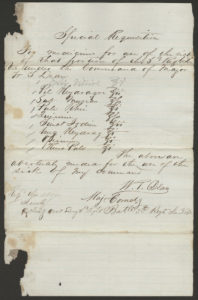
Special requisition of supplies requested by John G. Westmoreland, 1861.John G. Westmoreland papers, WHSC Library
Thank you for viewing our virtual tour!
Collections with materials in this exhibit:
J. Willis Hurst Papers, 1951-2009
Atlanta Medical College Records, 1854-1964
John G. Westmoreland papers, 1857-1932

